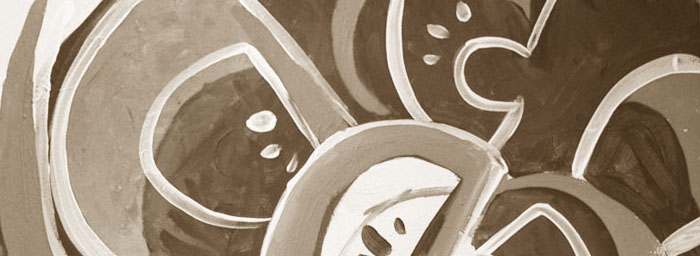 Here is a kind of sketch of Descartes' world as I understand his thought. We have these nice crystal clear distinctions, and there at the center we have our mind, our indivisible soul which suffers no change and houses all Rational Truth, the light of reason shines from there and lets us know that God exists and guarantees the truth of what we perceive to be true if we're careful enough. (God doesn't show up in the model, btw, because of the infinite and incomprehensible nature of said God, which is revealed in our thinking as incomprehensible, but also as perfect and existing. For Descartes anyway.) We are cut off from the world as a whole, the unbridgeable gulf you see is located precisely in the pineal gland, which is the place where our soul interacts with the world. Somehow. The objects of perception, the will and the emotions are all things that affect our thinking soul, and they are closer or further from the center depending on how directly they are related to the world or to the soul.
Here is a kind of sketch of Descartes' world as I understand his thought. We have these nice crystal clear distinctions, and there at the center we have our mind, our indivisible soul which suffers no change and houses all Rational Truth, the light of reason shines from there and lets us know that God exists and guarantees the truth of what we perceive to be true if we're careful enough. (God doesn't show up in the model, btw, because of the infinite and incomprehensible nature of said God, which is revealed in our thinking as incomprehensible, but also as perfect and existing. For Descartes anyway.) We are cut off from the world as a whole, the unbridgeable gulf you see is located precisely in the pineal gland, which is the place where our soul interacts with the world. Somehow. The objects of perception, the will and the emotions are all things that affect our thinking soul, and they are closer or further from the center depending on how directly they are related to the world or to the soul.This model has pervaded modern thought in a lot of ways.
Here is a kind of picture of what comes out of phenomenology if we were to try and make the same kind of diagram, which might just be a bad idea in this case (trying to throw a net over the whole world, as it were). But here we go anyway.
 So what we're looking at is the key differences here, as a true diagram may just be an impossibility. The first thing I am indicating here is that there are no hard lines really. We can kind of organize these various symbols into a kind of inner/outer order if we want to follow Descartes as much as we can, but everything is too interlinked to really separate one area from another. "MIND" on this diagram refers both to the minds of other individual people as well as collective minds that one is a part of or witness too, as well as the mind one is. We also have a kind of Klein bottle structure in which the absolute inside and the outside collapse. Both are mysterious, and everything revealed, all objects of consciousness, show up between them, never wholly inner or outer altogether. This is in stark contrast with the Cartesian model, in which thoughts are purely inner, and wholly independent of any possible world. Rational truths, like those of mathematics and logic, are for Descartes indubitable because of this distinction. In the phenomenological model, however, mathematical and logical truths are only indubitable from within their own systems of presuppositions, and there are no indubitable axioms whatsoever.
So what we're looking at is the key differences here, as a true diagram may just be an impossibility. The first thing I am indicating here is that there are no hard lines really. We can kind of organize these various symbols into a kind of inner/outer order if we want to follow Descartes as much as we can, but everything is too interlinked to really separate one area from another. "MIND" on this diagram refers both to the minds of other individual people as well as collective minds that one is a part of or witness too, as well as the mind one is. We also have a kind of Klein bottle structure in which the absolute inside and the outside collapse. Both are mysterious, and everything revealed, all objects of consciousness, show up between them, never wholly inner or outer altogether. This is in stark contrast with the Cartesian model, in which thoughts are purely inner, and wholly independent of any possible world. Rational truths, like those of mathematics and logic, are for Descartes indubitable because of this distinction. In the phenomenological model, however, mathematical and logical truths are only indubitable from within their own systems of presuppositions, and there are no indubitable axioms whatsoever.The place of the body is also wholly different here, as it blurs with the self as the self is revealed through it and as it. This also means that while the Cartesian model has a hard and fast line between the physical and the mental, there is no such line here.
I'm not entirely sure if these models make things more or less clear, but my goal here is to set them out as a first draft for consideration. I have strong suspicions that any such model will be at least partially misleading in the phenomenological case, but as a window into the contrast with the Cartesian worldview I think it might accomplish something. Maybe.

1 comment:
any sort of comparative graph is at least somewhat helpful, I think.
I think all of this is still, for me anyway, skirting just beyond my grasp, just baarely out of reach.
Post a Comment